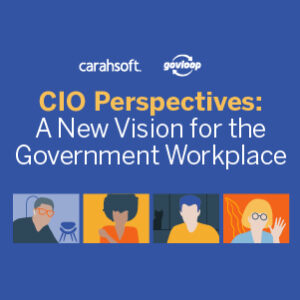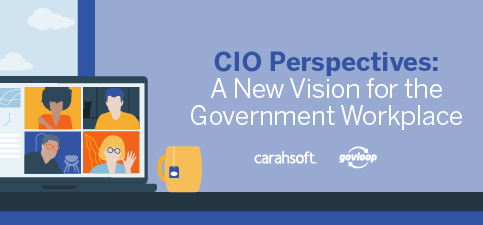In the early days of the COVID-19 crisis, most government chief information officers (CIOs) focused on fundamental questions related to transitioning to remote work and virtual environments while still maintaining services and meeting citizens’ needs. Over time, however, they realized that in responding to the crisis, agencies were crafting a new model for agency operations. In many cases, it was indeed possible to carry out the business of agencies in a virtual environment. Employees could stay engaged, work processes often were streamlined and digital services proved their worth. In part, the goal of this new model is to improve operational resiliency for the next crisis, but the new model also is geared toward transformation — helping agencies adopt more efficient and effective processes that deliver better services. Read more from CIOs within both Federal and state government on the lessons learned from the transition to telework and their goals for the future in “CIO Perspectives: A New Vision for the Government Workplace,” a guide created by GovLoop and Carahsoft featuring insights from the following technology leaders.
 Creating a Roadmap to Resilience
Creating a Roadmap to Resilience
“Resiliency means having the ability to rapidly resume delivery of services after a disruptive event and to continue operating in that new environment as long as needed. True resiliency goes beyond simply creating redundant capabilities that can ensure the availability of data and systems. It’s about taking a holistic approach to the people, processes, and systems involved in delivering services and ensuring that all three aspects are addressed as part of a continuity strategy. The ServiceNow platform is designed to help agencies create digital workflows that connect people, processes and systems. The platform is supported by a single data model and common application logic that makes it easy to automate processes and update those processes when requirements change.”
Read more insights from ServiceNow’s Chief Technology Officer of Global Government, Bob Osborn.
The Virtual Environment’s Key Attributes
“For many government employees, one of the biggest challenges of the remote work situation has been to continue effectively delivering on their mission critical operations. Virtual environments have become mainstream and indispensable for a variety of use cases, whether it’s large virtual gatherings, training sessions or meetings. It has been a paradigm shift, and if agencies can get it right, virtual environments could play a bigger role than ever even after the current crisis, reducing the need for travel, costs of large physical events, and providing more flexibility and reach… Whatever the situation, remote work has demonstrated that a virtual environment is not just a fallback plan, but a valuable option for agencies even in normal working conditions.”
Read more insights from Adobe Connect’s Senior Enablement Manager, Alistair Lee, and Product Evangelist, Peter Ryce.
Seeing Clearly With Network Visibility
“Government IT networks are increasingly difficult to manage. Citizens want digital services that are equal to the private sector’s. Cybersecurity risks, meanwhile, are multiplying daily. And the volume of data is growing faster than ever. The COVID-19 pandemic complicated this situation further for federal agencies. Whether they’re civilian or defense, these networks have been under unprecedented strain as most government employees have been working from home. Network visibility can help agencies see all these challenges clearly and solve them. Using the right tools, agencies can continuously monitor their networks’ performances and security.”
Read more insights from Gigamon’s Vice President of Public Sector, Dennis Reiley.
The 5 Elements of Government Digital Transformation
“Advanced operations through competencies such as Site Reliability Engineering (SRE) is about looking at transformation from an operational perspective. How well does a new digital service meet enterprise requirements for performance, reliability and security? …organizations should establish an enterprise-level minimum viable product (MVP) that lays out key requirements that all products must meet. In advising agencies going through an open transformation, Red Hat is not pushing a solution. Instead, these five elements are designed to help agencies think about the key decision areas they must address.”
Read more insights from Red Hat’s Digital Transformations Architect (DoD/IC), Dmitry Didovicher.
Unified Endpoint Security: Bringing Order to Chaos
“In cybersecurity, organizations create chaos with the best of intentions. Their goal is to make incremental gains in security by implementing new solutions that make up for the deficits of older ones and adding new controls to compensate for the limits of existing ones. To make matters worse, the IT environment itself has grown more complex, creating new attack vectors that malicious actors can exploit. Clearly, agencies need to reduce the chaos and improve security. But they also need to ensure their cyber strategy does not hinder employee productivity. Those competing needs were more apparent than ever when gubernatorial mandates in response to the COVID-19 crisis required thousands of employees to begin working from home, some using their own devices. How could agencies protect applications and data without creating new obstacles for employees? “
Read more insights from Blackberry’s Senior Vice President and Chief Information Security Officer, John McClurg.
Identity Access Management in the Telework Era
“Nationwide, agencies have embraced telework during the COVID-19 pandemic. While most agencies have rapidly transitioned to remote work, it hasn’t been without challenges. Many agencies couldn’t provide remote access to systems except email when the crisis first hit and as a result, workers couldn’t access many of the systems they use daily. At the same time, threat actors haven’t been sitting still, and attacks such as phishing and spear phishing are on the rise. Now, traditional network-oriented security isn’t sufficient with users accessing resources from more locations and devices than before. That is why identity and access management (IAM) is critical to helping agencies navigate this new normal. IAM covers the policies and tools ensuring the correct people have the appropriate access to organizational resources. “
Read more insights from Okta’s Senior Marketing Manager, Kelsey Nelson.
Election Security Is About More Than Voting Machines
“Conversations around election cybersecurity have gone mainstream. Much of those discussions focus largely on voting machines and known security flaws that hackers can use to compromise the technology. But that’s only a fraction of the larger issue…Today, as a pandemic rages across the globe, government agencies are exploring alternatives to in-person voting to promote social distancing. Even still, cybersecurity must remain an integral part of the conversation. “
Read more insights from Rapid7’s Research Director, Tod Beardsley.
How to Meet the IT Management Challenges of Remote Work
“Throughout the COVID-19 crisis, government agencies have learned two basic lessons about remote work. First, the experience has diminished doubts about whether employees could work effectively and efficiently outside the office. Second, it’s made IT leaders aware they need a better strategy for managing this remote environment… More than anything, the experience of remote work has taught IT managers to think in new ways about the enterprise.”
Read more insights from SolarWind’s Vice President of Product Strategy, Brandon Shopp.
Download the full GovLoop Guide for more insights from these telework and cybersecurity thought leaders and additional interviews and perspectives from government CIOs at FDIC, GSA, NRC, NSF, and the states of Colorado and Delaware.







